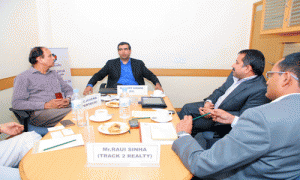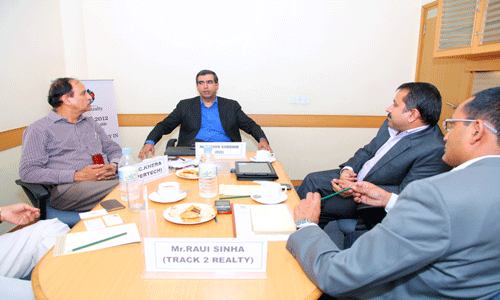Venue—India Habitat Centre
Moderator—Ravi Sinha, CEO & Managing Editor, Track2Realty
Panelists—Sachin Sandhir, MD, South Asia, RICS
Achal Agarwal, ED, Investments, Fire Capital
Sunil Dahiya, MD, Vigneshwara Developers
J C Khera, GM, Finance, Supertech
 Ravi Sinha: Sachin, if I come back to the topic of consumer redressal, isn’t it true that lack of clarity in policy leads to consumer blackmailing also in cases like CCI against DLF. How do you see that?
Ravi Sinha: Sachin, if I come back to the topic of consumer redressal, isn’t it true that lack of clarity in policy leads to consumer blackmailing also in cases like CCI against DLF. How do you see that?
Sachin Sandhir: The fact is there is activism happening at every level. And I think the industry is fairly receptive to change. We have changed for the better. I think one such issue with the CCI will trigger the next breed of people in the real estate industry.
Sunil Dahiya: My only concern is that the order particularly translates in to 2 crore per flat, which is a pretty steep penalty, whereas the flat value is 1.5 crore. So what is going to happen? Is DLF going to pay 2 crore per flat to the consumer and provide the flat to them as well?
Sachin Sandhir: But I don’t think they have decided not to challenge.
Sunil Dahiya: They have also not charged certain facilities they are providing as extra to the consumer.
Ravi Sinha: Yes, and that amounts to about 20-25 per cent of the project value. So, it seems to be more of consumer blackmailing than activism.
Sunil Dahiya: So I feel that in this order, there is disconnect where a quasi judiciary body wanted to frustrate a developer. Do they want to amend only one player in the market? I don’t think that should be the motive of any order. The order should be a judicial order and it should come as a correction method for the industry. My point is what happens now? DLF will say, okay we will deposit Rs. 630 crore which CCI has imposed on them. But where does that money go? That money goes into central judiciary treasury. It does not go to the consumer.
Ravi Sinha: What is your take on this Achal?
Achal Agarwal: The industry has been evolving, consumers are getting much more aware and technology has been enabling people to start talking about things much more easily. I will share an example. We have a project in a much more evolved market of Bangalore where there is a big forum run by consumers and actually they force the developers in a lot of ways to adopt the practices, addressing the grievances etc. They are very active in terms of raising the issues as a group. The collective power of the consumers becomes paramount.
Sachin Sandhir: Exactly the point I was trying to make. For every project now, consumers are setting up groups on Facebook, yahoo etc where people are posting comments and basically putting pressure on developers. There are groups for a large number of projects and what they are doing is basically rating the projects for other buyers. And this has gone up significantly in the last one year vis-a-vis the last 15 years.
Achal Agarwal: I think that CCI is an enabler, not necessarily the best way to do things. But what developers today are getting more pushed by is the consumer courts. CCI, I am not talking about the order in particular, there are issues and of course it just adds to the role of every party involved. It might not work in the present form. But the good thing about it is, let’s see it from the developer’s perspective, we need to understand that this market has evolved over time and we need to come to terms that the consumer is raising his voice as well.
…to be continued





